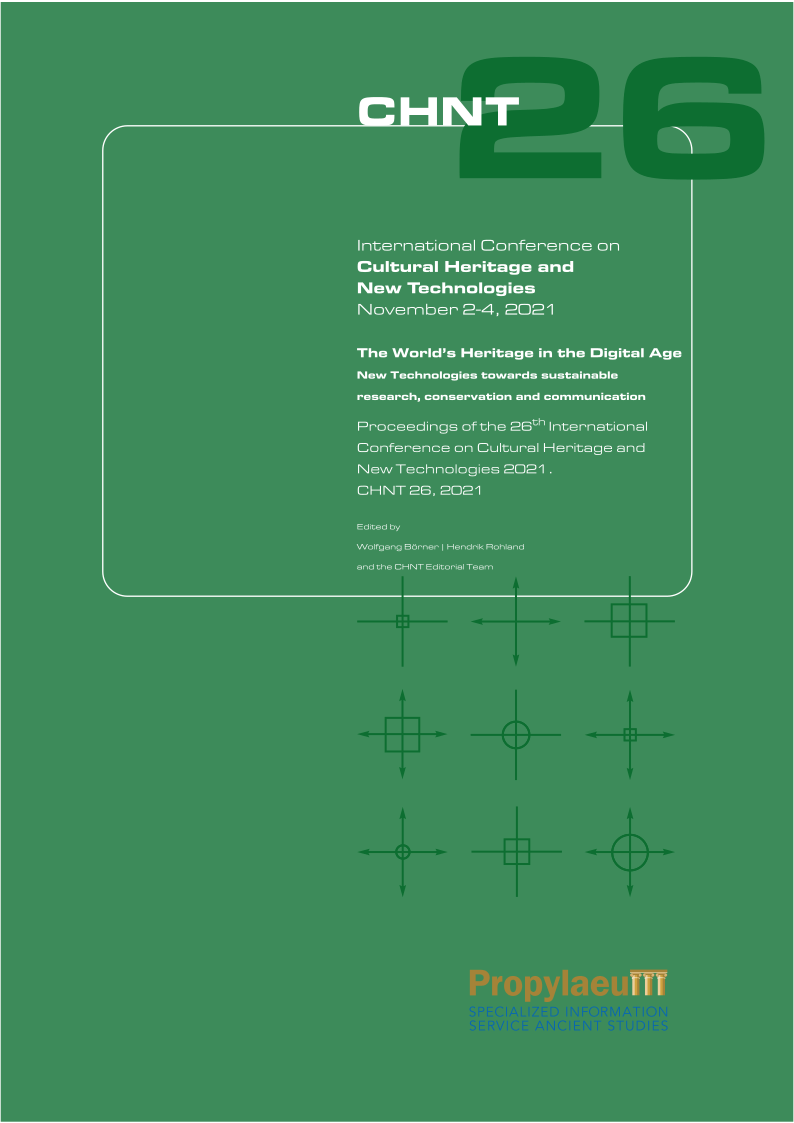Structured light scanning as a monitoring method to investigate dimen-sional changes due to climatic changes on cultural heritage
Keywords:
Structured Light Scanning, Cultural Heritage, Monitoring, Microclimate, Risk AssessmentAbstract
For a long-term preservation of cultural heritage items, stable climate conditions are necessary. As indoor temperatures will rise in the future due to climate change, chemical reactions take place much more quickly. At the same time, however, relative humidity decreases, which can cause damage, especially in the case of objects consisting of organic composite materials. As reactions to changes in climate depend very much on surrounding circumstances, on past climate patterns, and on the preservation history of an object (conservation treatments, changes in location, etc.), it is generally difficult to forecast future damage to cultural heritage objects that might be caused by climate change.
Comparable damage patterns can be found on cultural heritage items which have been subjected to the unfavourable climatic conditions over a longer period. This is usually due to excessive use, e.g., numerous events or the incorrect operation of cultural heritage items. This usually leads to inappropriate climatic conditions such as too high temperatures and too high or too low relative humidity combined with high climatic (short-term) fluctuations. Depending on the strain and the exposure time of the prevailing climate, this usually results in the appearance of cracks, loosening and loss of surfaces.
With the help of structured light scanning, it is possible to analyse the geometry of historic surfaces in detail and correlate the observed changes with climate measurements. This helps not only to conduct high-resolution monitoring, but also to carry out an individual risk analysis for cultural heritage objects. Two case studies with different composite materials and questions will be used to demonstrate the potential of surface monitoring with structured light scanning: monitoring the effect of climate change on the baroque leather panels in Moritzburg Castle as well as the impact of the conversion of the former Dominican church of St. Christopher in Bamberg ...
References
Bratasz, L. (2013). ‘Allowable microclimatic variations for painted wood’, Studies in Conservation (58), pp. 65–79.
Erhardt, D. and Mecklenburg, M. (1994). relative-humidity re-examined, Preventive Conservation. Practice, theory and research. International Institute for Conservation of Historic and Artistic Works Ottawa, 12–16, September 1994. Lon-don. pp. 32–38.
Lukomski, M. (2012). ‘Painted wood. What makes the painting crack?’, Journal of Cultural Heritage, Vol. 13, pp. 90–93.
Mecklenburg, M. (2010). Determining the acceptable ranges of relative humidity and temperature in museums and galleries. Part 1 Structural response to relative humidity available at http//:www.si.edu/mci/downloads/reports/Mecklenburg-Part1-RH.pdf (Accessed: 25 January 2022).
Michalski, S. (2011). Agent of deterioration: Incorrect relative humidity. Available at: https://www.canada.ca/en/conservation-institute/services/agents-deterioration/humidity.html#det3 (Accessed: 25 January 2022).
Brasseur, G. P., Jakob, D. and Schuck-Zöller, S. (Eds.) (2017). Klimawandel in Deutschland, Entwicklung, Folgen, Risi-ken und Perspektiven, New York.
Schulze, A. (1997). ‘Die Ledertapeten im Schloß Moritzburg‘, Magirius, H. and Dülberg, A. (eds.) Denkmalpflege in Sachsen 1894–1994. Teil I, Weimar, pp. 229–240.
Schulze, A. (1998). ‘The application of the „low pressure” technology in the conservation of gilt leather wall hangings in situ – a report about our experiences’, The Conservation of Gilt Leather / La Conservation du cuir doré, Postprints of the 5th Interim Meeting in Brussels (25.–27.03.1998). ICOM-CC, pp. 32–35.
Pallas, L. (2020). Monitoring as a maintenance concept in cultural heritage buildings using the example of the former Dominican church in Bamberg, Master Thesis unpublished.
Hoyer, S. (2009). Die Wandmalereien der Dominikaner in Bamberg. Kunsttechnologische Analyse des Malereibestandes und beispielhafte Vermittlung komplexer Zeitschichten. PhD. University of Bamberg.
Eipper, P. B., Frankowski, G., Opielka, H. and Wenzel, J. (2004). Ölfarben-Oberflächenreinigung. Die Reinigung der Öl-farbenoberflächen und ihre Überprüfung durch das Raster-Elektronen-Mikroskop, das Niederdruck-Raster-Elektronen-Mikroskop, die Laser-Profilometrie und die 3D-Messung im Streifenprojektionsverfahren, Munich.
Drewello, R., Wetter, N., Rahrig, M. and Bellendorf, P. (2011). ‘3D-Dokumentation mittelalterlicher Glasmalerei mit der Methode der 3D-Weißlicht-Streifenprojektion‘ Konservierung mittelalterlicher Glasmalerei im Kontext spezieller mate-rieller und umweltbedingter Gegebenheiten, Stuttgart, pp. 142–154.
Holl, K., Rahrig, M. and Janis, K. (2017). Multi-view-monitoring of dimensional changes of wooden panels due to changes in the microclimate at Linderhof Palace, Preventive conservation in historic houses and palace-museums: Assessment methodologies and applications, Palace of Versailles November 29th – December 1st 2017. pp. 272– 283, Available at https://www.larcroa.fr/wp-content/uploads/ROCHE_VERSAILLES_2017-vers-anglaise.pdf (Accessed: 25 January 2022).
Downloads
Published
Conference Proceedings Volume
Section
License
Copyright (c) 2025 Kristina Holl, Leander Pallas, Paul Bellendorf

This work is licensed under a Creative Commons Attribution-ShareAlike 4.0 International License.
The CHNT older Proceedings are licensed under the creative commons license CC BY-NC-ND 3.0.
From the issue 26 on, they will be licensed under the creative commons license CC-BY-SA 4.0


